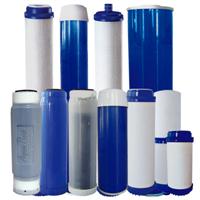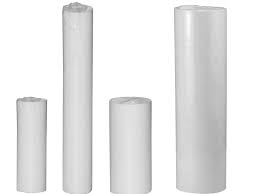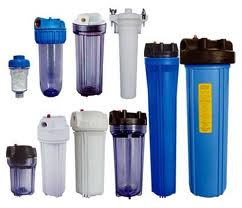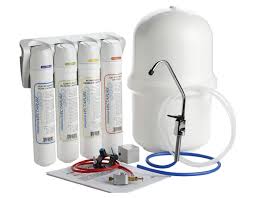All About Water Filters – Cartridge Based Systems
Water filters are composed of a substance that either trap, adsorbs, or modifies the contaminants in the water which flows through them. This substance they are made of is called the medium or media.
There are many different types of filter media. Some mechanically trap pollutants with an ultrafine sieve or web and act like a tea strainer that traps the particles that you do not want in the water as the water flows through. Others use a process called absorption in which contaminants are retained within the microscopic pores of the medium or adhesion where the particles are attracted almost like a magnet to the molecules of the media.
Sediment Filters
In the mechanical type of filter you will always see a rating which will tell you what size particles it will and won’t remove. Filters are rated in microns. A micron is one millionth of a metre. A human hair is 70 microns in diameter, a cryptosporidium oocyst 4-6 microns and a Giardia cyst 8 – 12 microns.
There are two types of filter ratings: nominal and absolute. A nominal rating indicates the smallest particle size that the filter should remove or reduce, in accordance with its design criteria. It is an estimated value, not a precise one. A 5 Micron nominal filter, for example should trap 95 per cent of all particles 5 microns or larger. An absolute filter rating refers to a certified reduction rate, usually 99.9 per cent. Therefore a 5 Micron absolute filter will remove 99.9 per cent of particles 5 microns or more in diameter.
These “mechanical” filters are most often used to remove sediments and are very commonly used if the water comes from a lake or river source. They are often referred to as sediment or particulate filters and are fine sieves which reduce dirt and other particles. They are used as pre filters to other treatment systems as well as UV lights. Using them as a pre-filter will often protect a water purifier from damage and extend its life..
Sediment filters range from less than 1 micron to about 70 microns but the most typically used are 5, 10, 20, 25, 30, 50. They would typically be used in a sequence with the biggest “pore” size or micron size being the first one the water goes through and the smallest the last.
Sediment filter cartridges can be made from wound string, rigid foam or pleated film. They are most often made of a substance called Polypropylene which is resistant to the growth of bacteria. However cellulose is sometimes used. For residential use, they typically come in four sizes which are 10’ and 20’ tall and 2” and 4” radius. They are typically referred to as either Slim Line or Big Blue.
Slim Line 10” and 20” and Big Blue 10” and 20” Filter cartridges
These cartridges are inserted into filter housings that are installed as part of the plumbing of the home or cottage. They can be installed in a basement or utility room or smaller systems can even be installed under the kitchen sink. (See RO systems) The housings and cartridges are interchangeable in most cases, so you can buy the best value brand cartridge and do not have to stay with the brand originally installed.
Activated Carbon Filters
Activated carbon filters are particularly effective at removing pollutants which create unpleasant taste, colour, and odour in water. These fast-acting filters can eliminate or reduce the levels of chlorine by-products, pesticides, herbicides, and other organic and industrial chemicals.
Activated carbon is made from a variety of organic materials such as coal, coconut, lignite, and wood. When these are activated by exposure to high temperatures in the absence of oxygen, the result is a substance with millions of microscopic pores and a vast surface area; half a kilo of activated carbon provides more than 50 hectares of surface with the capacity to cling to or absorb smaller organic molecules.
There are two forms of carbon in general use: granular and block. Carbon granules are about the size of coarse sand while carbon block is finely powdered carbon compressed into a solid mass. Typically carbon filters are 5 micron but can be different. A 5 micron carbon block filter is often the filter of choice before a UV light. UV lights must have a minimum 5 micron pre filter to ensure that proper disinfection occurs. By using a carbon block at this stage the taste of the water is also improved. Sometimes a carbon filter is referred to as a “polishing” filter.
To get the most of a carbon filter, it should be kept free of sediment and heavy organic impurities. Typically an inexpensive sediment filter used as a “pre filter” would be installed prior to the carbon unit to extend the life of the more expensive carbon cartridge.

Reverse Osmosis Purifiers
Osmosis is a process which occurs when two solutions of different concentrations are separated by a semi-permeable membrane. Reverse osmosis water purification works by forcing the water under pressure against an ultrafine semi-permeable membrane designed to allow single water molecules to permeate through, while at the same time rejecting most contaminants. The membrane acts as a mechanical filter, straining out particulate matter, micro-organisms, asbestos, even single molecules of heavier organic compounds.
A typical RO purifier consists of four filters in series plus a storage tank. The first is a sediment filter, the second a carbon block, the third a membrane and the fourth a activated carbon block to remove any remaining chlorine by-products.
Such a system removes a wide spectrum of impurities from water.
Reverse osmosis effectively removes turbidity, sediment, colloidal clays, total dissolved solids, toxic metals, radioactive elements, pesticides, and herbicides. This can have significant health benefits.
A typical system produces water at a slow rate – almost drop by drop – so most under sink systems have a pressurised storage tank and a separate dedicated faucet or all in one three way mixer installed on the sink. Water drawn from the faucet or mixer comes from the storage tank.
The average system produces about 200 liters per day, more than enough for an average family. Higher yielding membranes can be installed but they are more expensive.
Unlike filters, RO membranes don’t accumulate pollutants but the membranes themselves gradually degrade with use. While the sediment and carbon filters will probably need replacement every 6 – 12 months, membranes should be changed every 2-3 years or as specified by the manufacturers.
Whole home RO systems are available but in addition to be expensive they require a large amount of space as water storage reservoirs are required.
At Muskoka Clean Water we are always happy serve you. Bring in a sample of your water and we will recommend exactly what type of water treatment your water requires to give you the best results.


